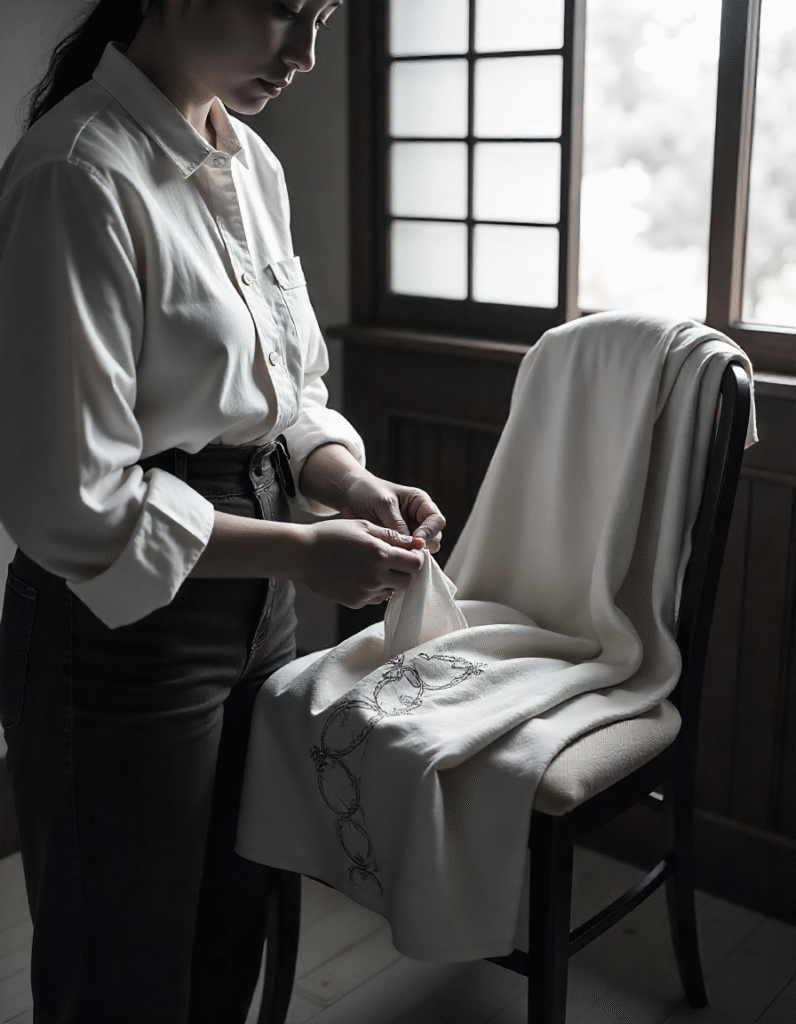Clothing is our most intimate architecture. From the moment we dress each morning, we construct a personal landscape that signals who we are—or who we aspire to be. Yet in an era of algorithmic trend cycles and disposable fashion, we’ve lost touch with this profound truth. What we wear has been reduced to either a performance for others or a mindless routine. We scroll through curated feeds, absorbing style directives without questioning their origin or purpose. The result? A collective identity crisis reflected in our closets: garments that feel like costumes rather than extensions of self. This isn’t about rejecting fashion; it’s about reclaiming its deeper purpose. Clothing isn’t just fabric. It’s the silent language through which we navigate the world, protect our vulnerabilities, and declare our place in the human tapestry.
The Forgotten Language: Clothing as Cultural Dialogue
For millennia, clothing communicated status, belief, and belonging before words were exchanged. In ancient Rome, the purple-edged toga praetexta immediately signaled political authority. Japanese kimono patterns once revealed marital status, age, and even the wearer’s mood. Scottish tartans identified clans, while African adinkra symbols encoded wisdom and values. These weren’t mere uniforms; they were visual dialects of identity.
Fast forward to today, and this language has been diluted into globalized homogeneity. Walk down any major city street, and you’ll see the same fast-fashion silhouettes, the same logo-emblazoned hoodies, the same “it” bags replicated endlessly. We’ve traded cultural specificity for accessibility, losing the nuance that made clothing meaningful. When everyone wears the same Zara jumpsuit or Uniqlo basics, individuality erodes. We become visual static rather than distinct voices.
This homogenization isn’t accidental. It’s the result of an industry built on rapid consumption. Fast fashion giants like Shein upload 6,000 new styles daily, flooding the market with trend-driven pieces designed for obsolescence. There’s no time to develop a relationship with clothing when it’s outdated before the credit card bill arrives. We’ve become fluent in consumption but illiterate in the language of personal style.
The Armor We Wear: Clothing as Psychological Protection
Beyond social signaling, clothing serves as psychological armor. We choose outfits to shield insecurities, project confidence, or conform to expectations. The “power suit” phenomenon isn’t just corporate lore—it’s documented psychology. Studies show that formal clothing enhances abstract thinking and feelings of power. Conversely, wearing worn-out sweats can trigger a slump in focus and self-perception.
This armor becomes problematic when it’s built for others’ eyes rather than our own. Many women admit to owning “skinny jeans” they’ll never wear again—purchased during a moment of aspiration or societal pressure. Men keep stiff, uncomfortable dress shirts in closets for interviews that never materialize. These garments aren’t just unused; they’re monuments to disconnection from self.
Consider the phenomenon of “dressing for the body you want” versus “dressing for the body you have.” The former often leads to ill-fitting, uncomfortable clothing that signals dissatisfaction. The latter embraces current reality, fostering self-acceptance. Universal Standard, the size-inclusive brand, built its philosophy on this distinction. Their marketing features real women of diverse body types wearing clothes that fit now, not after weight loss. Sales skyrocketed because they addressed a psychological truth: clothing should honor, not punish, the wearer.
The Authenticity Paradox: When Fashion Becomes Performance
Social media has transformed getting dressed into a performance art. Outfits are staged for photos, accessories are props, and “authenticity” is often just another aesthetic. The rise of “quiet luxury” and “stealth wealth” trends—where logos disappear but price tags remain astronomical—reveals a new layer of performativity. It’s no longer about showing off brands; it’s about signaling cultural capital through subtle “taste.”
This performance creates exhausting cognitive load. We’re not just choosing clothes; we’re curating personas. A 2023 study by the University of Chicago found that young adults spend an average of 45 minutes daily deciding what to wear, driven by anxiety about social judgment. This isn’t style; it’s anxiety management.
True style—the kind that feels like a second skin—requires shedding these layers of performance. It starts with asking uncomfortable questions:
- Am I wearing this because I love it, or because I think I should?
- Does this outfit allow me to move, breathe, and exist comfortably?
- Would I choose this if no one would see me?
Eileen Fisher’s brand philosophy embodies this introspection. Her designs prioritize comfort, timelessness, and versatility. The famous “System” dressing approach—mixing simple, high-quality pieces—encourages wearers to build a personal uniform rather than chase trends. It’s fashion as self-care, not spectacle.
Cultural Counterpoints: Where Clothing Still Speaks
While mainstream fashion often feels hollow, subcultures and traditional communities keep clothing’s communicative power alive. These movements offer blueprints for reclaiming meaningful style:
Japanese Street Fashion: Harajuku’s eclectic styles—from Lolita to Decora—treat clothing as artistic expression. Outfits are meticulously crafted, often handmade, and deeply personal. They reject conformity in favor of joyful individuality. Importantly, this isn’t about attention-seeking; it’s about community. Participants recognize each other’s codes, creating belonging through visual language.
Scandinavian Minimalism: Brands like Ganni and COS embrace “quiet luxury” not as status signaling but as functional beauty. The focus is on quality materials, clean lines, and versatility. A well-cut wool coat or perfectly tailored trousers becomes a long-term companion rather than a seasonal fling. This approach values durability over disposability, reflecting cultural values of sustainability and pragmatism.
Indigenous Textile Revival: From Maori korowai (cloaks) in New Zealand to Oaxacan embroidery in Mexico, traditional crafts are being reclaimed by younger generations. These garments carry ancestral knowledge, environmental wisdom (natural dyes, local fibers), and cultural pride. Wearing them isn’t a fashion statement; it’s an act of cultural reclamation.
Slow Fashion Communities: Online collectives like The Fold and Birdsong connect consumers directly with artisans. Customers learn the stories behind their clothes—the weaver in India using ancient techniques, the seamstress in London paid a living wage. This transparency transforms clothing from commodity to connection.
Building Your Second Skin: A Framework for Authentic Style
Reclaiming clothing’s power isn’t about rejecting fashion or adopting uniforms. It’s about intentional curation. Here’s how to start:
1. Audit Your Emotional Closet
Empty your wardrobe and handle each piece. Ask:
- When do I feel most like myself in this?
- Does this restrict or empower me?
- What memories or emotions does this hold?
Discard anything that triggers shame, discomfort, or inauthenticity. Keep pieces that align with your values and daily reality.
2. Define Your Style Vocabulary
Identify 3-5 words that describe your ideal style (e.g., “earthy,” “structured,” “playful”). Use these as filters for future purchases. Levi’s did this masterfully with their “Live in Levi’s” campaign, focusing on durability and authenticity over trends.
3. Prioritize Tactile Experience
Order fabric swatches before buying. Touch materials. Do they feel good against your skin? Natural fibers (cotton, linen, wool) often develop a patina that synthetic materials can’t replicate. Brother Vellies, known for handmade shoes, emphasizes this sensory connection—their leather ages uniquely, telling the wearer’s story.
4. Embrace Repair and Evolution
Mend holes visibly with sashiko stitching or patches. Alter pieces to fit your current body. Style isn’t static; it should evolve with you. Patagonia’s Worn Wear program celebrates this by repairing garments and sharing customers’ stories of well-loved gear.
5. Create Rituals Around Dressing
Treat getting dressed as a mindful practice. Light a candle, play music, or simply pause to consider your needs for the day. This shifts clothing from chore to self-dialogue.
The Future of Fashion: From Consumption to Conversation
The most exciting shift in fashion isn’t technological—it’s philosophical. Emerging movements prioritize relationship over transaction:
Rental and Resale: Platforms like Rent the Runway and Vestiaire Collective extend garments’ lives, turning ownership into temporary stewardship. This reduces waste while encouraging experimentation.
Customization: Brands like Unspun use 3D weaving to create jeans made-to-measure, eliminating waste and ensuring perfect fit. This moves fashion from mass production to personal dialogue.
Digital Identity: As virtual worlds grow, fashion is becoming a way to express digital selves. But the most interesting projects—like The Fabricant’s digital couture—focus on artistry over commerce, treating clothing as cultural expression rather than status.
Conclusion: Dressing as an Act of Self-Respect
Clothing is never neutral. It either connects us to ourselves or distances us from our truth. In a world that constantly tells us who to be, choosing what to wear becomes a radical act of self-definition. The most powerful style isn’t found in magazines or on runways. It emerges when we listen to our needs, honor our bodies, and express our values through what we put on each day.
Your second skin shouldn’t constrict or disguise you. It should move with you, protect you, and announce your presence without words. It should feel like coming home to yourself. That’s the true power of clothing—not to transform you into someone else, but to help you become more fully, unapologetically you.






